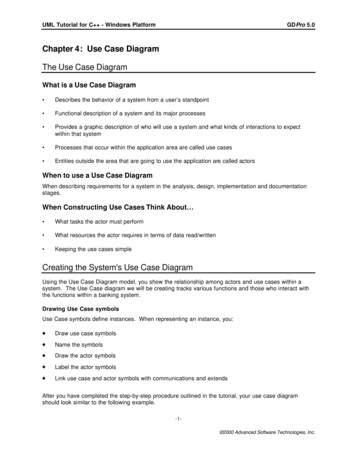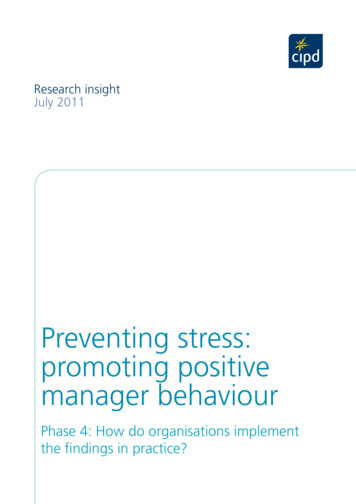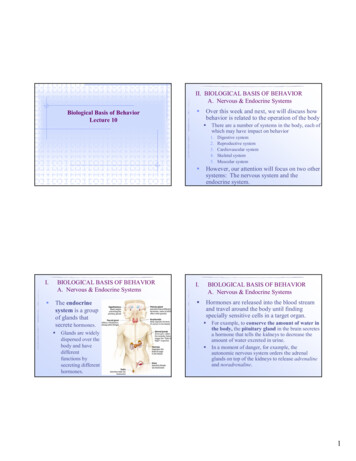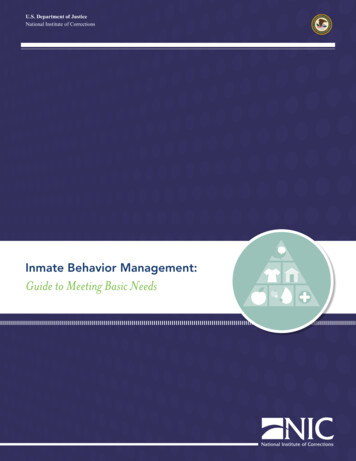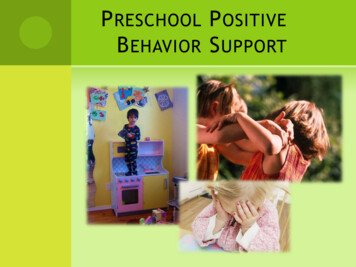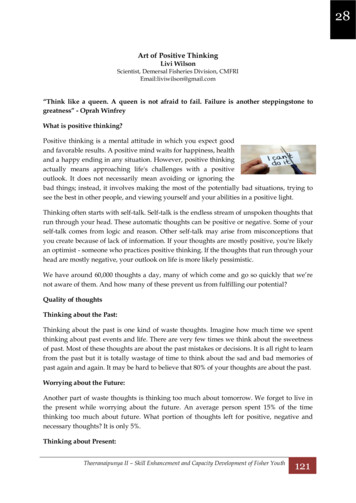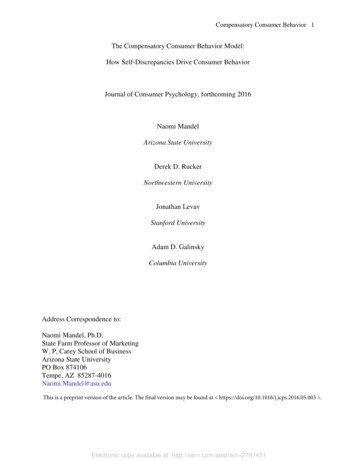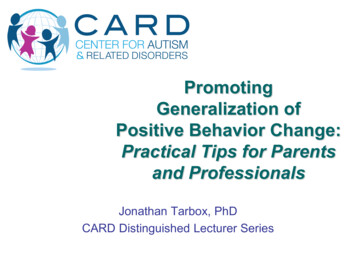
Transcription
PromotingGeneralization ofPositive Behavior Change:Practical Tips for Parentsand ProfessionalsJonathan Tarbox, PhDCARD Distinguished Lecturer SeriesCenter for Autism & Related Disorders, Inc.
CARD Distinguished Lecturer Series What is the Distinguished Lecturer Series?– Open to everyone– Free of charge– Outreach and education for the community– Targeted toward parents and professionals Source of the material is scientific research, but Tone is purposefully non-technical; user-friendly I’m hoping this talk will be of some practical use toyou– Feel free to raise your hand and askquestions at any time
Brief Introduction to CARD CARD was founded by Dr. Doreen Granpeeshehin 1990 Dr. Granpeesheh received her PhD from Lovaasat UCLA We provide intensive behavioral educationalservices to children with autism and relateddisorders We have multiple offices in the U.S. and officesin England, Australia, and New Zealand
Who Am I? My job is Co-Director of Research andDevelopment I direct research projects which investigate theeffectiveness of real-life interventions forchildren with autism I direct the development of new internal andexternal projects (e.g., curricula, internal andexternal training, etc.) I am giving this talk because I love talking withparents – you are truly on the front lines, 24hours a day, forever Now for tonight’s talk
The CARD Perspective Our science is Applied Behavior Analysis, or“ABA” Our perspective is that scientific knowledgeregarding the causes of learning and motivationcan be applied to everything people do:–––––LanguageSocial skillsEmotional understandingAcademic behaviorExecutive function Other acronyms: AVB, VBA, PRT, NET, NLP,PBS – all are facets or groups within ABA
Topic What is “Positive Behavior Change?”– Behavior change means that someone isdoing something differently than they used to– Positive behavior change simply meanssomething you did as a parent or professionalaffected something that a child does in apositive way
Topic Terminology note: “Behavior” does notmean “bad behavior,” as in “He had a lotof behaviors today” Behavior is anything anyone does, bad orgood
Topic What is “Generalization?”– It’s a “spreading” or “expansion” of teaching,beyond what was directly or intentionally done– Example: explicitly teach turn-taking to a childat school and then the child starts taking turnsat home with siblings or friends, even thoughno one ever tried to teach turn-taking at home
Generalization Three Types of Generalization (examples)– 1. Across people: Teach a child to say hi to a Sally and he/she thensays hi to other people as well (stimulusgeneralization)
Generalization Three Types of Generalization (examples)– 2. Across settings: Teach a child to wash her hands before a meal atschool and then she washes her hands beforemeals at home, even though no one has taught herto wash her hands before meals at home (stimulusgeneralization)
Generalization Three Types of Generalization (examples)– 3. Across behaviors: Teach a child to add “s” on to the end of the words“tree,” “car,” and “dog,” when referring to morethan one, and then he/she does so with othernouns, without having to be taught each nounindividually (response generalization)
Relevance of Generalization What is so special about generalization? It is nothing less than the goal of behaviorchange (e.g., education, therapy, etc.) If a child is not affected in a positive wayacross most or all of his/her life, then thechange is not very meaningful Examples: potty training, learning torequest items, decreasing tantrums
Generalization is Not Automatic Unfortunately, generalization is notautomatically guaranteed If you don’t do something to intentionallymake it happen, you should expect it tonot happen Individuals with autism tend to have aparticularly difficult time with generalization This is true in home life and at school
Generalization is Not Automatic Any time you change an individual’sbehavior, whether it’s child or a client, planon intentionally making generalizationhappen from the start It’s not something extra; it has to be acentral part of every intervention and everyparenting strategy, and if it doesn’thappen, then behavior change is all butmeaningless
Generalization is Not Automatic How generalization occurs– Discrimination is the opposite of generalization. Itmeans that a behavior only occurs in the presence ofa particular stimulus (e.g., person, place, or thing)because it was only taught in the presence of thatstimulus– If you have high discrimination, you have lowgeneralization– Generalization occurs when you have NOT onlytaught a behavior in the presence of one stimulus;when you teach it in the presence of many– The rest of this talk describes methods for doingthis
Methods for Generalization Overview of the Remainder of the Talk1.2.3.4.5.Teaching many examplesTeaching across many peopleTeach with multiple instructionsChoose “functional” behaviorsLearning occurs 24-hours per day
Teach Many Examples The most reliable way to getgeneralization is to teach many differentexamples Technical term is “training sufficientexemplars” This can be done across people, settings,objects, behaviors, or any other relevantdimension
Teach Many Examples Example: teachingthe word “car”
Teach Across Many Different People It’s the same basic logic as teaching manydifferent examples If you want a child to do something in thepresence of many different people, make sureand have many different people teach him/her Generalization across people is going to bebetter if a child has several different teachers,rather than just one
Teach Across Many Different People At home: make all parents / siblings /grandparents, etc., teach the child the samething– Example: not giving in to whining. All parents mustnot give in to whining; it’s not enough if only mom ordad does it– Make sure whenever Johnny wants something, hehas to ask for it without whining, even if he is askinggrandma
Teach Across Many Different People At school:– Use all available staff. If you have a teacher and anaid or two in the classroom, make sure all take turnsteaching the same thing to the child across the day– Staff taking turns with the different students in aclassroom enhances generalization and also giveseveryone a much-needed break– Make sure all school staff are trained on theprocedure (e.g., regular teacher, resource roomteacher, SLP, PT, etc.)
Teach Across Many Different People Parent-supervised ABA programs:– Make sure your child has more than one therapist– It’s more work for you to hire, train, and managethem, but it’s absolutely crucial and is considered anindustry standard now– Staff will last longer and not burn out as quickly too
Teach with Multiple Instructions A skill is not really generalized if a child can onlyrespond to one particular instruction, when it isstated in exactly the same way If a child understands what you have taughtthem, you should be able to say it in a coupledifferent ways This is another variation on teaching manyexamples
Teach with Multiple Instructions Example: teaching a child to come and sit athis/her desk when asked. The child should beable to respond to many different instructionsthat all mean the same thing:–––––––“Come sit please”“Time for work”“Time to come sit at your desk”“Come and sit down”“Let’s go do some work”“Come over to the table”“Come here”
Teach with Multiple Instructions It’s very common for children with autism toNOT automatically generalize understanding tovarious instructions which all mean the samething What to do? Start with teaching one When the child learns that, teach another, whilestill using the old one occasionally When the child has the second (and maintainsthe first), then teach another, and so on
Teach with Multiple Instructions Eventually, when a particular child has learnedin this way enough times, you can start byteaching with multiple instructions from thebeginning when teaching new skills But be careful this equals NOT beingconsistent, which we know can be harmful withnewer learners
Choose “Functional” Behaviors Teach behaviors which are likely to beuseful to the child in his/her everyday life Put another way, all behavior changeshould result in the child being able toindependently get reinforcement out ofhis/her environment Example: teaching the child to requestthings he/she wants (technical term is“mand”)
Choose “Functional” Behaviors A VERY common mistake in working withchildren with autism and other developmentaldisorders is teaching new skills that are notuseful– May not really improve the child’s life– The skill may not maintain, even in the setting inwhich it was taught– The skill may not generalize to other settings orpeople– Most importantly, there is no ongoing source ofreinforcement for the behavior in everyday life
Choose “Functional” Behaviors Very common problematic example:teaching a child to say or sign “please” or“more,” rather than teaching him/her to askfor what they want Why is saying or signing “please” or“more” less functional than learning to askfor the particular thing one wants?
Choose “Functional” Behaviors Because it doesn’t actually identify forthe listener what the child wantsThe child must also point or gesture, andthe item must therefore be in sight orwithin reachIf a child walks around his classroomsaying “please,” it’s not likely to continueto be maintained, relative to if he/she canindicate what, in specific, he/she wants
Choose “Functional” Behaviors So how would you do it?Start by figuring out what the child wants,in each setting where you would like tosee communication occur (preferenceassessments)Then teach a simple form ofcommunication for the child’s favoriteitemStart easy (e.g., picture card, signlanguage, short vocal approximation)
Choose “Functional” Behaviors Once the child is asking for one thingconsistently, then:– Teach another, and another, and so on – Once the child can ask for several highlypreferred items or activities (and continuesto do so without help), then you can worryabout increasing difficulty (e.g., requiring afull word or sentence, etc.)
Learning Occurs 24-Hours per Day Establishing generalization should not onlyoccur during planned timesPre-planned times are necessary, but Every moment that the child is awake isanother opportunity to learn somethingThis is especially true for generalizationWhy? Because the child is usually not intherapy or school, they are usually in theirnatural environment, and things learned in thatenvironment are likely to maintain in thatenvironment
Learning Occurs 24-Hours per Day Examples:– Regardless of where you are or what time itis, if a child wants something, that’s anopportunity to practice generalizing requests(mands)– Regardless of where you are or what time itis, when you pass by an object that the childknows the name of, that’s an opportunity topractice generalizing naming andcommenting
Troubleshooting Don’t blame the child or the diagnosis– More than 30 years of research prove thatchildren with autism and otherdevelopmental disabilities can learn goodbehavior and generalize it– If what you did isn’t generalizing, it is yourjob to make it work and to never give up– Blaming the diagnosis or the “functioninglevel” of the child doesn’t help figure out howto fix the problem
Troubleshooting Be systematic––––Try one approach at a timeBe consistentDon’t give upGive it enough time to give it a chance towork, BUT – It’s better to work yourself into the ground fora week, and give the treatment a good shot,then to give it a half attempt for a month
Troubleshooting Baby steps––Don’t expect to get generalization in huge steps; it’susually in very small stepsExample: single site words whole sentences. Taught child with autism to read many single site words onflashcardsChild was not automatically able to read sentences in a bookThe generalization situation was too different from theteaching situation–– Book has several words in a rowReading a sentence before getting a reinforcer is harder thanreading one word before getting a reinforcerSolution was to step back a couple steps: have child readtwo flashcards in a row, then three, etc.,Then reading from a book was no problem
Troubleshooting Baby steps––––Another example: decreasing non-compliance withsmall tasks and then expecting it to be gone withlarger tasksTreatment for non-compliance: if child completes onesmall step of one small task, he gets a break and abig reinforcerThis may work very well, but then don’t expect thechild to immediately be able to complete a 10 minutetask to earn the same reinforcerIncrease difficulty and length of task very slowly; onlyincrease when the previous step is successfulconsistently; be patient
Troubleshooting Watch out for prompt-dependence– When you use a prompt to teach a child to dosomething (e.g., modeling the word “juice” forthe child), the child may become dependenton the prompt and the desired behavior maynot occur if the prompt does not happen– This is called “prompt dependence”– It can prevent generalization because noteveryone will give the prompt in every setting– Very common in children with autism
Troubleshooting Avoiding prompt dependence– As soon as the child starts to do thebehavior, start fading back your prompts Introduce delays before prompts (e.g., hold upsomething the child wants, but wait a coupleseconds before modeling the appropriaterequest)Gradually decrease physical assistance (e.g.,fade full physical guidance to light physicalguidance, etc.)Gradually decrease vocal prompts (e.g., insteadof modeling “cookie,” model “cook ”)
Troubleshooting Keep it simple– Often times, the simplest solution is the best– Example: rewarding small attempts atschool work with big breaks andpraise then gradually increase work– Keeping things simple will make it easier foryou and others to do it and make it easier forthe child to understand– Worry about fine-tuning later, after you havebeen successful with something simple
The Bottom Line Acquisition / intervention is only thebeginningGeneralization is not guaranteed – itneeds to be fought forGeneralization, itself, requires explicitplanning and intervention
The Bottom Line If you taught a child a good behavior orhelped him/her decrease a challengingbehavior, your job has just begunNow, figure out how you are going tospend at least twice as much timefollowing up and forcing generalizationas you did in teaching it to begin with
The End Never give up!Questions?Also, feel free to email me with questionsat j.tarbox@centerforautism.com and thispresentation will be available todownload from our website athttp://www.centerforautism.com
means that a behavior only occurs in the presence of a particular stimulus (e.g., person, place, or thing) because it was only taught in the presence of that stimulus – If you have high discrimination, you have low generalization – Generalization occurs when you have NOT only taught a


